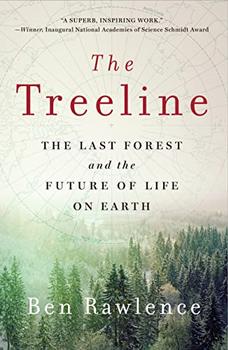Summary | Excerpt | Reviews | Beyond the Book | Readalikes | Genres & Themes | Author Bio

The Last Forest and the Future of Life on Earth
by Ben Rawlence
Around 8500 BCE pollen records show Scots pine (Pinus sylvestris) arriving suddenly across Britain, colonizing a corridor up the west coast of the British Isles, nosing its way into the inlets and fjords of Scotland and then across the straths and valleys and up into the mountains. Pine out-competed the birch and oak that had generously worked up sufficient soil for it to flourish. So successful was the pine that the birch disappeared almost completely for thousands of years, surviving only in a remnant zone in the flow country north of what is now the city of Inverness.
This pine wood spread across Scotland, reaching its apex of around 80 percent of the land area, according to Rackham, around 4500 BCE. Recent archaeology, pollen analysis and even the 7,000-year-old bones of pine trees preserved in bogs have fed debate about the scale and the fate of Scotland's once magnificent wildwood.4 Conservationists are seeking a record to guide their attempts at "ecological restoration." Opponents are seeking evidence that the trees were eliminated through natural causes and that the current status quo of grouse moors and deer parks is just as deserving of the designation "natural." At issue, it seems, is one vision of nature over another, neither of which attributes much influence to humans for creating the shape of the landscape in the first place, and yet the history of humans and the history of the forest is deeply entwined.
Before driving north, I read a scientific paper by Lithuanian researchers demonstrating that the DNA of the Scots pine in the eastern half of Scotland came from a refugium—a place where species survived the last ice age—near Moscow around 9000–8000 BCE.5 Previous DNA analysis has shown that the surviving pines in the west of Scotland came from the Iberian peninsula in modern-day Portugal and Spain. In both cases the seed migrated to Scotland on timescales hundreds of times faster than is possible through natural succession. The most likely vehicle for such rapid migration was humans.
There is a myth in Celtic folklore—with an apparent grain of truth—that when the Celts colonized Scotland they met Ukrainians coming the other way. For the Celts, the pine was a sacred tree with a myriad of uses. The pine was ailm in the Celtic alphabet, the ogham script, and it is very likely that they brought it with them from Ireland and Wales. It was perhaps sacred too for the mysterious Ukrainians, who were part of the Celtic kingdom, "the people of the Danube" in old Irish, the only others with red hair. For humans so tied to nature and reliant on plants it would make sense to travel with your own habitat. Something twenty-first-century humans might soon wish we were able to do.
The result, in the present day, is two distinct genetic communities of Scots pine in Scotland divided by the Highlands. They have yet to cross-pollinate and conservationists are keen that they do not since the genetic and chemical distinctiveness has consequences for other species that rely on the keystone of the pine. Insects like wood ants, for example, can taste differences in resin and will choose particular trees as a result. Leaf chemistry, flower timings and growth forms are all different. The crested tit remains east of the Cairngorms, embedded in its environment. However, the conservationists needn't worry yet. The risk of interbreeding is minimal since the fragments of surviving forest are spread out and very small. Less than 1 percent of Scotland's old-growth pine woods remain.
Rackham argues that the pine wood never stretched from shore to shore, but it certainly covered most of Scotland until Mesolithic humans began to clear the forest for agriculture, hunting and construction. Managing the forest through felling, clearing or burning for game played a role in creating biodiverse habitats of heath and moor, but also set the stage for the creeping blanket bog that has become upland Britain's signature landscape. The bog is, in a sense, a ruined ecosystem as tree clearance has allowed minerals and iron to be washed into the lower layers of the soil, creating a pan impermeable to water. Unable to drain, the tundra-type landscape becomes waterlogged, and plants do not fully decompose, forming peat.
Excerpted from The Treeline by Ben Rawlence. Copyright © 2022 by Ben Rawlence. Excerpted by permission of St. Martin's Press. All rights reserved. No part of this excerpt may be reproduced or reprinted without permission in writing from the publisher.
Your guide toexceptional books
BookBrowse seeks out and recommends the best in contemporary fiction and nonfiction—books that not only engage and entertain but also deepen our understanding of ourselves and the world around us.